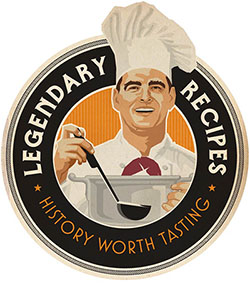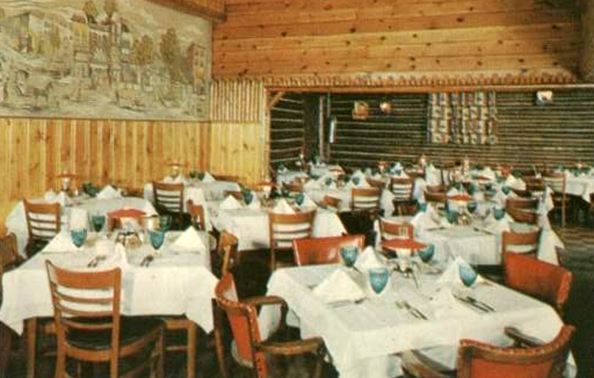Four may have been the charm for Tom Brown, as legions of customers came to know Chicago restaurateur Thomas F. Brown in the two decades immediately following World War II.
His first restaurant, Tom Brown’s Cafe Lounge, opened at 1102 Granville Avenue in 1945 and quickly gained a loyal following for its aged steaks and for lobster and other seafood that, as its newspaper ads said, were “flown in daily.” Next, in 1952, came Tom Brown’s Skokie Restaurant, at 8617 Niles Center Road in the upscale Chicago suburb of Skokie. And then, in 1955, came Tom Brown’s Blackboard Club, a members-only “key club” with assorted bon mots gracing blackboards on the walls of its main dining room and a kitchen headed by Sam DeFino, who’d been the chef at the Granville Avenue restaurant, which Brown had just closed.
As Brown was opening his third establishment, George Holt, the owner of the Embers restaurant at 1034 North Dearborn Street in the Gold Coast neighborhood of Chicago, was opening an outpost in the Lincoln Square neighborhood on the city’s North Side. He called it the Coach Light, and it occupied a space at 5200 North Lincoln Avenue that since 1939 had been occupied by Potter’s Stockade, whose owners, William and Bessie Potter, were eager to retire and move to Florida. The Coach Light on November 12, 1954, but Holt’s attention soon turned to another venture, and in March 1956 Brown became the new owner of the Coach Light, and, as was his custom, affixed his name to the marquee.
Brown had a partner in the venture: Frank Helsing, the co-owner, with his brother, of Helsing’s Vodvil Lounge, a restaurant and nightclub at Sheridan Road and Montrose Avenue. This was, to say the least, an unusual establishment. Billing itself as “America’s Most Outstanding Theatre Lounge,” it was attached at the hip to the “Bowlium,” an ultramodern, 24-hour-a-day facility with 30 bowling alleys and nary a column to block anyone’s view of spectators. As for the Vodvil Lounge, it was best known for being the longtime home of Al “Flying Fingers” Morgan, the immensely popular pianist and nightclub singer, and the place where comedian George Gobel had gotten his start in 1948.
At his new restaurant, Brown reprised many of the dishes that had been hits at his first place, including aged steaks and live Maine lobsters. Other specials included roast prime rib of beef (served with onion pie) and an Alaskan king crab platter. Every meal started with a complimentary relish tray and, for many, ended with a slice of one of Brown’s trademark cheesecakes—plain, apricot, chocolate, coconut, or maple walnut—prepared by Ernest Lasenby, the restaurant’s pastry chef.
In the end, though, Tom Brown’s Coach Light Restaurant didn’t fare much better than its predecessors. In 1963 Brown closed it and moved to the Granada Apartment Hotel, also in Chicago’s Lincoln Park neighborhood, at 525 West Arlington Place, giving his new place an old name: Tom Brown’s Cafe Lounge.
Brown retired from the restaurant business in 1971. He died in Duluth, Minnesota, in 1983 at age 81.

Sauerkraut Balls
Sauerkraut balls are said to have been introduced in the 1940s by Gruber’s, a restaurant in Shaker Heights, Ohio, and further popularized by the Brown Derby chain of Los Angeles restaurants. The original Gruber's recipe later found its way into the pages of McCall's magazine, and not long after that Duncan Hines later served up the recipe in his syndicated newspaper column, “Adventures in Good Eating.” Before long sauerkraut balls could be found in restaurants from coast to coast. Tom Brown’s Coach Light Restaurant in Chicago was known for its sauerkraut balls, which which were similar to those at Gruber's, and Gourmet magazine memorialized the recipe in in 1958 in its “You Asked For It” column.
Ingredients
- 3 tablespoons unsalted butter
- 1 onion, finely chopped
- 1 cup cooked ham, finely chopped
- 1 cup corned beef, finely chopped
- 1/2 clove garlic, minced and mashed to a paste
- 6 tablespoons all-purpose flour
- 2 cups sauerkraut, drained and finely chopped
- 1 tablespoon fresh parsley, finely chopped
- 1/2 cup beef broth
- 1 large egg
- 2 cups milk
- 2 1/2 cups all-purpose flour
- 4 cups fine, dry breadcrumbs
- Vegetable oil, for frying
Instructions
In a large skillet over medium-low heat, melt the butter. Add the onion and cook, stirring occasionally, until softened, about 5 minutes. Stir in the ham, corned beef, and garlic, cooking for 1 minute more. Sprinkle in 6 tablespoons of flour and stir constantly for 3 minutes to form a roux. Add the sauerkraut, parsley, and beef broth, stirring until the mixture thickens to a paste-like consistency, about 3 minutes. Spread the mixture onto a platter and refrigerate for at least 3 hours.
In a medium bowl, whisk together the egg, milk, and 2 1/2 cups of flour to create a batter. Shape the chilled sauerkraut mixture into balls using a teaspoon as a measure. Dip each ball into the batter, then roll in breadcrumbs to coat thoroughly.
In a heavy-bottomed pot or deep fryer, heat 2 inches of vegetable oil to 375 degrees. Fry the sauerkraut balls in batches, turning occasionally, until golden brown, 2 to 3 minutes. Use a slotted spoon to transfer to a paper towel-lined plate to drain.










No Comments